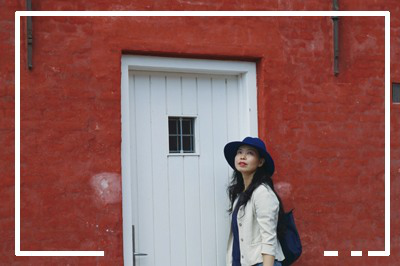
Lin Cunzhen [Photo/clady.com]
The emblems of the Beijing 2022 Winter Olympics and Winter Paralympics, named "Winter Dream" and "Flying High", were officially released at the National Aquatics Center on December 15.

Winter Dream, the emblem of the Beijing Winter Olympic Games [Photo/clady.com] Flying High, the emblem of Beijing Paralympic Winter Games [Photo/clady.com]
At the event, the emblems' designer, Lin Cunzhen, was also announced. Lin recently shared her life story and expressed her thoughts about her profession.
Make Decisions
Since Lin was a child, she loved drawing her dreams using color and lines. However, this artistic girl grew up with a rational mind. "When at school, I was no good at liberal arts, but I excelled in science", she said.
When Lin was in elementary school, she got a computer from her mother, who is a member of the Chinese Academy of Sciences. "It was a tiny computer. I learned to program with my brother. We were self-taught," Lin recalled.
"When I was in high school, I thought there's no way that I would choose to study liberal arts, because I found it difficult to memorize things," said Lin.
However, in her senior year, she learned that Beijing Institute of Graphic Communication would admit science students to study design. Lin changed her mind and took this opportunity without hesitation.
After a busy and happy college life, Lin found a job in the Press and Publication Administration upon graduation. A year later, she took over the Art and Design magazine, which was about to close down, with her friend. Just as the magazine started to make a profit, Lin chose yet another path for her life. She went to pursue advanced studies in University of Visual Arts, Leipzig, Germany.
Three years later, she went back to China and started her teaching career at Central Academy of Fine Arts (CAFA). Now, at 45, she is the vice dean of the School of Design at CAFA. Looking back at her life, Lin can always seize the right opportunity at the right time. "My parents were busy. I made my own decisions even when I was a child. I would consider my parents' advice, but ultimately I called the shots," Lin said.
'Conquer Yourself'
As the world marvels at the design made by Lin and her team, a multitude of feelings surges up in her heart. She had a sense of relief when hearing that her design, after being redone and modified numerous times, finally passed the review.
However, this is not the first time Lin has worked for the Olympics. Lin started to do jobs related to the Olympics when she was the assistant for the dean of School of Design of CAFA in 2003.
In 2006, she was temporarily transferred to the Image and Landscape Division of the Organizing Committee of the Olympic Games. In 2014, she designed the emblem for the Nanjing Youth Olympic Games. In 2015, she drafted the logo for the Olympic bid.
On July 31, 2016, the Organizing Committee of 2022 Winter Olympic Games (OCWOG) sent an invitation worldwide, soliciting designs for emblems.
Following her love for design, Lin participated. After several rounds of assessments, Lin's work stood out among 4,506 proposals.
In January 2017, after deliberation by the OCWOG, four works were selected out of 10 short-listed designs to be further modified and perfected.
Design No. 801 by Lin was one of them.
She said, "The time allowed for modification was extremely tight. I was notified to modify on January 23, and submit the first modification on February 6. This was during the Spring Festival period, but all of us overcame the difficulty."
She met a lot of challenge in the modification stage. "The most difficult thing is to conquer yourself, to come up with a new design. It is difficult to break your regular thinking," said Lin, who nearly collapsed during the process that lasted over eight months.
"I am grateful for my team and my family, whose advice and encouragement supported me."
Lin said she is most satisfied with her design for the Winter Olympic Games. "I thought the graphic design is an organic integration of sports, Chinese culture and globalism. Besides, the design applied new dynamic and three-dimensional techniques, meeting our expectations."
Full of Curiosity
As a prestigious designer, Lin's path to success seems clear. In the eyes of many, she is a goal-oriented person, while her comment on herself is, "I'm full of curiosity."
She loves to experience new things. She is an outstanding tennis player, and she plays golf with her friends in spare time. She is also a fan of skiing and skating. Lin said she would try things that she is interested in. After getting the hang of it, she would go on to find another hobby.
Curiosity also brought her into charity. In 2009, she started a poverty relief project with a friend, helping women from a poor village in southwest China's Guizhou Province to make money by embroidery.
She said, "I told them to embroider exactly the way their grandmother taught them, and anything goes." She successfully turned this into a project that involved more than 100 women, and later managed to exhibit their works in New York. "We even receive orders from abroad," gushed Lin.
Best Design
Lin explained further about her profession: "An outstanding designer should be passionate about life. I often tell my students to be curious about life. A designer should not be impassive about things. If you are thoughtful, so will your works. A stingy person will never design something grand.
"Your design resembles your personality. Works by a designer passionate about life will touch people.
"Empathy is also important. Designers are not artists, who express their thinking and feelings in their works. Some may find their works interesting, while others may not. Regardless, artists often go, 'Whether you like it or not is none of my concern.' This simply doesn't work for designers.
"Designing a book, for instance, requires the designer to do the utmost to improve the reading experience, to help readers better understand the plot and to create visual changes in line with emotional alternations."
Asked about the best sort of design, Lin said: "The best designs are invisible. Designers should not be presumptuous. They should put themselves in others' shoes. For example, when designing a park, you should think from the perspective of a public administrator. You should also think as a visitor – would I get lost in this park? A designer has to put herself in others' position."
"Designs do not depend on inspiration. Materials or crafts cannot guarantee a good design, for design is different from arts and crafts. Take the design of the emblem of the Winter Olympic Games as an example, the graphics and colors are suitable not only for the Winter Olympic Games, but for the current Chinese culture, the taste of the masses and sportsmen as well.
"It requires a lot of research that cannot be fulfilled solely by inspiration.
"I have a huge ambition: whatever I do in the future, I will shoulder the responsibility of promoting Chinese culture. This is also a necessary quality for good designers, especially for Chinese designers. We should learn and promote our culture.
"When I was a student in Germany, many foreigners would come to me to learn about Chinese culture. And I often tell my students to study Chinese culture carefully, and promote it through their work.
"In the future, I will utilize the Olympic Games as a platform to further promote Chinese culture," she concluded.
